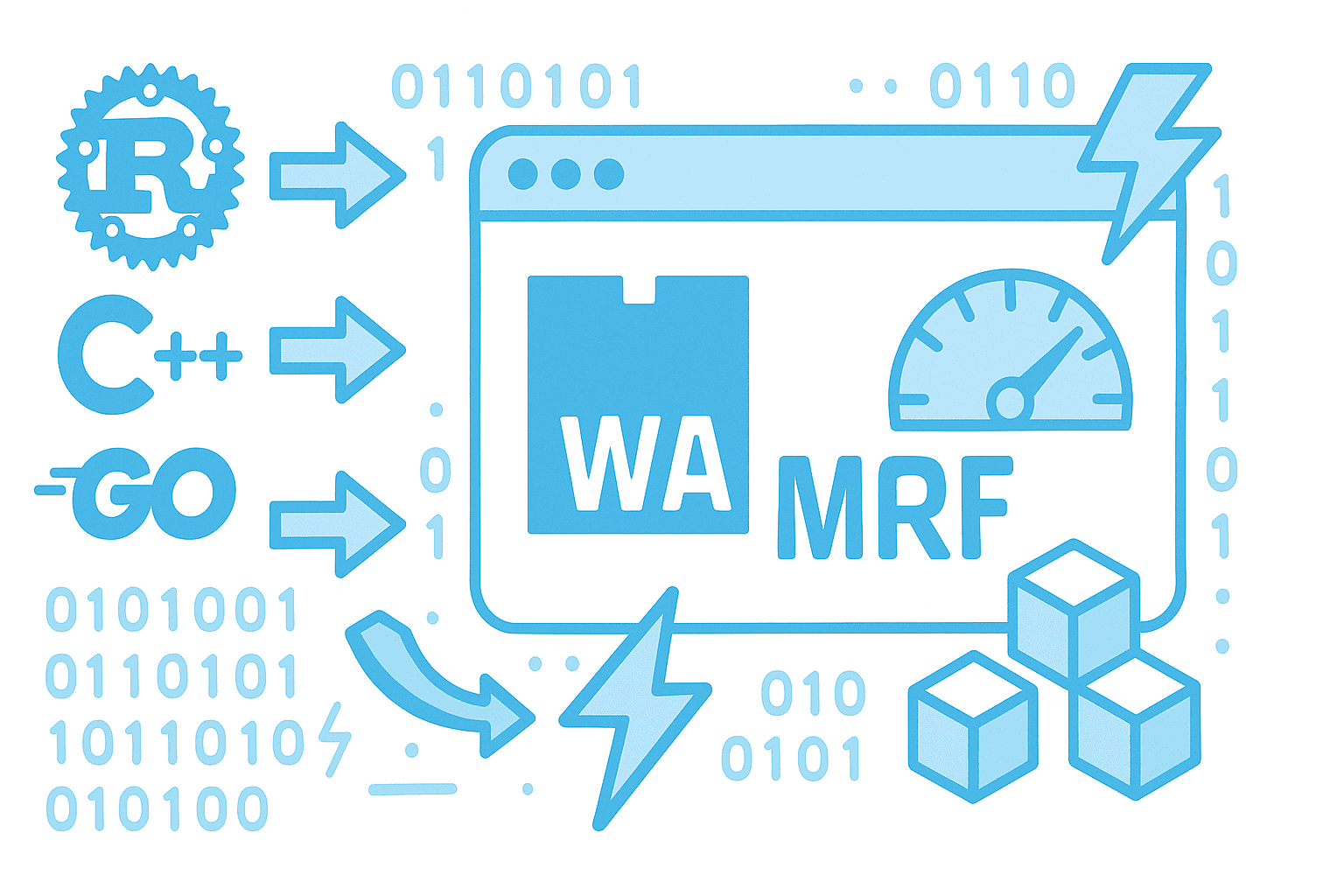Introduction to WebAssembly 3.0
WebAssembly 3.0 (WASM 3) represents a major milestone in web development technology, bringing unprecedented performance capabilities and new features that revolutionize how we build web applications. Released in 2024, WebAssembly 3.0 builds upon the foundation of its predecessors while introducing game-changing improvements that make it easier to compile, deploy, and run high-performance code in web browsers.
This comprehensive guide will walk you through everything you need to know about WebAssembly 3.0, from its core features to practical implementation examples.
What is WebAssembly 3.0?
WebAssembly (abbreviated as Wasm) is a binary instruction format designed as a portable compilation target for programming languages. WebAssembly 3.0 is the latest major version that extends the capabilities of web browsers to execute code at near-native speeds, enabling developers to run performance-critical applications directly in the browser.
Key Improvements in WASM 3.0
WebAssembly 3.0 introduces several revolutionary features that set it apart from previous versions:
Core Features of WebAssembly 3.0
1. Enhanced Garbage Collection (GC)
WebAssembly 3.0 includes a fully-featured garbage collection proposal that allows languages like Java, Kotlin, Dart, and Python to compile more efficiently to WebAssembly. This means:
- Reduced Memory Overhead: Better memory management with automatic cleanup
- Improved Language Support: High-level languages can now run without bundling their own GC
- Better Performance: Native GC integration eliminates the need for custom memory management
2. Component Model
The Component Model is perhaps the most significant addition to WebAssembly 3.0. It enables:
- Modular Architecture: Build reusable WebAssembly components
- Language Interoperability: Mix and match components written in different languages
- Interface Types: Standardized communication between components
- Virtualization: Better sandboxing and security
3. Tail Call Optimization
Functional programming languages benefit greatly from tail call optimization, which:
- Enables efficient recursion without stack overflow
- Improves performance for functional programming paradigms
- Supports languages like Scheme, OCaml, and F#
4. Exception Handling
Native exception handling in WASM 3 provides:
- Better Error Management: Handle exceptions across language boundaries
- Performance Improvements: Native exception handling is faster than JavaScript interop
- Language Parity: Languages like C++ and Rust can use their native exception mechanisms
5. SIMD Extensions (Enhanced)
Single Instruction, Multiple Data (SIMD) capabilities have been expanded:
- 256-bit SIMD operations
- Improved multimedia processing
- Enhanced cryptographic operations
- Better AI/ML workload support
6. Multi-Memory Support
WebAssembly 3.0 allows modules to use multiple linear memories:
- Better memory isolation
- Improved security boundaries
- Efficient large-scale applications
7. Threads and Atomics (Improved)
Enhanced threading capabilities include:
- Better synchronization primitives
- Improved shared memory handling
- Advanced concurrent programming support
Why Choose WebAssembly 3.0?
Performance Benefits
- Near-Native Speed: Execute code at speeds comparable to native applications
- Smaller Binary Sizes: Optimized compilation produces compact binaries
- Fast Load Times: Streaming compilation allows instant startup
Cross-Platform Compatibility
- Universal Browser Support: Works across Chrome, Firefox, Safari, and Edge
- Server-Side Execution: Run WASM modules in Node.js, Deno, and dedicated runtimes
- IoT and Edge Computing: Deploy to resource-constrained environments
Security Advantages
- Sandboxed Execution: Code runs in a secure, isolated environment
- Memory Safety: Built-in protections against buffer overflows
- Fine-Grained Permissions: Control what WASM modules can access
Setting Up a WebAssembly 3.0 Project
Prerequisites
Before starting, ensure you have the following installed:
- Node.js (v18 or later)
- Rust (for Rust-based projects) or your preferred language compiler
- wasm-pack (for Rust projects)
- A modern web browser
Option 1: Setting Up with Rust
Rust is one of the most popular languages for WebAssembly development. Here's how to get started:
Step 1: Install Rust and wasm-pack
# Install Rust
curl --proto '=https' --tlsv1.2 -sSf https://sh.rustup.rs | sh
# Install wasm-pack
curl https://rustwasm.github.io/wasm-pack/installer/init.sh -sSf | sh
# Add the WebAssembly target
rustup target add wasm32-unknown-unknown
Step 2: Create a New Project
# Create a new library project
cargo new --lib wasm-hello-world
cd wasm-hello-world
Step 3: Configure Cargo.toml
[package]
name = "wasm-hello-world"
version = "0.1.0"
edition = "2021"
[lib]
crate-type = ["cdylib"]
[dependencies]
wasm-bindgen = "0.2"
[profile.release]
opt-level = "z" # Optimize for size
lto = true # Enable Link Time Optimization
codegen-units = 1 # Reduce parallel code generation units
Step 4: Write Your Rust Code
Edit src/lib.rs:
use wasm_bindgen::prelude::*;
#[wasm_bindgen]
pub fn greet(name: &str) -> String {
format!("Hello, {}! Welcome to WebAssembly 3.0!", name)
}
#[wasm_bindgen]
pub fn fibonacci(n: u32) -> u32 {
match n {
0 => 0,
1 => 1,
_ => fibonacci(n - 1) + fibonacci(n - 2),
}
}
#[wasm_bindgen]
pub struct Calculator {
value: f64,
}
#[wasm_bindgen]
impl Calculator {
#[wasm_bindgen(constructor)]
pub fn new() -> Calculator {
Calculator { value: 0.0 }
}
pub fn add(&mut self, num: f64) {
self.value += num;
}
pub fn subtract(&mut self, num: f64) {
self.value -= num;
}
pub fn multiply(&mut self, num: f64) {
self.value *= num;
}
pub fn divide(&mut self, num: f64) {
self.value /= num;
}
pub fn get_value(&self) -> f64 {
self.value
}
pub fn reset(&mut self) {
self.value = 0.0;
}
}
Step 5: Build the Project
wasm-pack build --target web
This creates a pkg directory with your compiled WebAssembly module.
Step 6: Create an HTML File
Create index.html:
<!DOCTYPE html>
<html lang="en">
<head>
<meta charset="UTF-8" />
<meta name="viewport" content="width=device-width, initial-scale=1.0" />
<title>WebAssembly 3.0 Demo</title>
<style>
body {
font-family: Arial, sans-serif;
max-width: 800px;
margin: 50px auto;
padding: 20px;
}
.demo {
background: #f5f5f5;
padding: 20px;
border-radius: 8px;
margin: 20px 0;
}
button {
background: #007bff;
color: white;
border: none;
padding: 10px 20px;
border-radius: 4px;
cursor: pointer;
}
button:hover {
background: #0056b3;
}
input {
padding: 8px;
margin: 5px;
border: 1px solid #ddd;
border-radius: 4px;
}
</style>
</head>
<body>
<h1>WebAssembly 3.0 Demo</h1>
<div class="demo">
<h2>Greeting Function</h2>
<input type="text" id="nameInput" placeholder="Enter your name" />
<button onclick="showGreeting()">Greet Me</button>
<p id="greetingOutput"></p>
</div>
<div class="demo">
<h2>Fibonacci Calculator</h2>
<input type="number" id="fibInput" placeholder="Enter a number" />
<button onclick="calculateFib()">Calculate</button>
<p id="fibOutput"></p>
</div>
<div class="demo">
<h2>WebAssembly Calculator</h2>
<input type="number" id="calcInput" placeholder="Enter a number" />
<button
onclick="calc.add(parseFloat(document.getElementById('calcInput').value))"
>
Add
</button>
<button
onclick="calc.subtract(parseFloat(document.getElementById('calcInput').value))"
>
Subtract
</button>
<button
onclick="calc.multiply(parseFloat(document.getElementById('calcInput').value))"
>
Multiply
</button>
<button
onclick="calc.divide(parseFloat(document.getElementById('calcInput').value))"
>
Divide
</button>
<button onclick="calc.reset()">Reset</button>
<p>Current Value: <span id="calcOutput">0</span></p>
</div>
<script type="module">
import init, {
greet,
fibonacci,
Calculator,
} from "./pkg/wasm_hello_world.js";
let calc;
async function run() {
await init();
calc = new Calculator();
window.calc = calc;
window.greet = greet;
window.fibonacci = fibonacci;
window.showGreeting = showGreeting;
window.calculateFib = calculateFib;
}
function showGreeting() {
const name = document.getElementById("nameInput").value;
const greeting = greet(name);
document.getElementById("greetingOutput").textContent = greeting;
}
function calculateFib() {
const num = parseInt(document.getElementById("fibInput").value);
const result = fibonacci(num);
document.getElementById(
"fibOutput"
).textContent = `Fibonacci(${num}) = ${result}`;
}
// Update calculator display
setInterval(() => {
if (calc) {
document.getElementById("calcOutput").textContent = calc.get_value();
}
}, 100);
run();
</script>
</body>
</html>
Step 7: Serve Your Application
# Install a simple HTTP server
npm install -g http-server
# Serve the application
http-server . -p 8080
Visit http://localhost:8080 to see your WebAssembly 3.0 application in action!
Option 2: Setting Up with AssemblyScript
AssemblyScript is a TypeScript-like language that compiles to WebAssembly.
Step 1: Initialize a New Project
npm init -y
npm install --save-dev assemblyscript
npx asinit .
Step 2: Write AssemblyScript Code
Edit assembly/index.ts:
// Simple math operations
export function add(a: i32, b: i32): i32 {
return a + b;
}
export function multiply(a: i32, b: i32): i32 {
return a * b;
}
// String manipulation
export function reverseString(input: string): string {
let result = "";
for (let i = input.length - 1; i >= 0; i--) {
result += input.charAt(i);
}
return result;
}
// Array processing
export function sumArray(arr: Int32Array): i32 {
let sum: i32 = 0;
for (let i = 0; i < arr.length; i++) {
sum += arr[i];
}
return sum;
}
// Performance-intensive: Prime number checker
export function isPrime(n: i32): bool {
if (n <= 1) return false;
if (n <= 3) return true;
if (n % 2 === 0 || n % 3 === 0) return false;
for (let i = 5; i * i <= n; i += 6) {
if (n % i === 0 || n % (i + 2) === 0) return false;
}
return true;
}
Step 3: Build the Project
npm run asbuild
Step 4: Use in JavaScript
import { instantiate } from "./build/release.js";
instantiate().then(({ exports }) => {
console.log(exports.add(5, 10)); // 15
console.log(exports.multiply(4, 7)); // 28
console.log(exports.isPrime(17)); // true
});
Option 3: Using C/C++ with Emscripten
Step 1: Install Emscripten
git clone https://github.com/emscripten-core/emsdk.git
cd emsdk
./emsdk install latest
./emsdk activate latest
source ./emsdk_env.sh
Step 2: Write C Code
Create hello.c:
#include <emscripten.h>
#include <stdio.h>
EMSCRIPTEN_KEEPALIVE
int factorial(int n) {
if (n <= 1) return 1;
return n * factorial(n - 1);
}
EMSCRIPTEN_KEEPALIVE
double calculateCircleArea(double radius) {
return 3.14159 * radius * radius;
}
EMSCRIPTEN_KEEPALIVE
void greet(const char* name) {
printf("Hello, %s from WebAssembly!\n", name);
}
Step 3: Compile to WebAssembly
emcc hello.c -o hello.js \
-s WASM=1 \
-s EXPORTED_FUNCTIONS='["_factorial","_calculateCircleArea","_greet"]' \
-s EXPORTED_RUNTIME_METHODS='["ccall","cwrap"]'
Step 4: Use in HTML
<!DOCTYPE html>
<html>
<head>
<title>C/C++ WebAssembly Demo</title>
</head>
<body>
<h1>C WebAssembly Functions</h1>
<button onclick="runDemo()">Run Demo</button>
<pre id="output"></pre>
<script src="hello.js"></script>
<script>
Module.onRuntimeInitialized = function () {
window.factorial = Module.cwrap("factorial", "number", ["number"]);
window.calculateCircleArea = Module.cwrap(
"calculateCircleArea",
"number",
["number"]
);
};
function runDemo() {
const fact5 = factorial(5);
const area = calculateCircleArea(10);
document.getElementById(
"output"
).textContent = `Factorial of 5: ${fact5}\nArea of circle (r=10): ${area.toFixed(
2
)}`;
}
</script>
</body>
</html>
Advanced WebAssembly 3.0 Examples
Example 1: Image Processing with SIMD
Here's a Rust example using SIMD for fast image processing:
use wasm_bindgen::prelude::*;
#[wasm_bindgen]
pub fn grayscale_simd(image_data: &mut [u8]) {
for chunk in image_data.chunks_exact_mut(4) {
let r = chunk[0] as u32;
let g = chunk[1] as u32;
let b = chunk[2] as u32;
// Calculate grayscale value
let gray = ((r * 299 + g * 587 + b * 114) / 1000) as u8;
chunk[0] = gray;
chunk[1] = gray;
chunk[2] = gray;
}
}
#[wasm_bindgen]
pub fn apply_brightness(image_data: &mut [u8], factor: f32) {
for chunk in image_data.chunks_exact_mut(4) {
chunk[0] = ((chunk[0] as f32 * factor).min(255.0)) as u8;
chunk[1] = ((chunk[1] as f32 * factor).min(255.0)) as u8;
chunk[2] = ((chunk[2] as f32 * factor).min(255.0)) as u8;
}
}
Example 2: Web Worker Integration
Leverage WebAssembly 3.0 in Web Workers for parallel processing:
// worker.js
importScripts("./pkg/wasm_module.js");
let wasmModule;
wasm_bindgen("./pkg/wasm_module_bg.wasm").then((module) => {
wasmModule = module;
postMessage({ type: "ready" });
});
self.onmessage = function (e) {
if (e.data.type === "process") {
const result = wasmModule.heavy_computation(e.data.input);
postMessage({ type: "result", data: result });
}
};
// main.js
const worker = new Worker("worker.js");
worker.onmessage = function (e) {
if (e.data.type === "ready") {
worker.postMessage({
type: "process",
input: largeDataSet,
});
} else if (e.data.type === "result") {
console.log("Processed result:", e.data.data);
}
};
Example 3: Component Model Usage
Using the WebAssembly Component Model:
// Define a component interface
wit_bindgen::generate!({
world: "calculator",
exports: {
world: Calculator,
},
});
struct Calculator;
impl Guest for Calculator {
fn add(a: f64, b: f64) -> f64 {
a + b
}
fn complex_calculation(params: CalculationParams) -> Result<f64, String> {
// Component can communicate with other WASM components
Ok(params.value * 2.0)
}
}
Performance Optimization Tips
1. Use Appropriate Data Types
- Use
i32andf64for optimal performance - Avoid unnecessary type conversions
- Leverage SIMD types for parallel operations
2. Minimize JavaScript Interop
- Batch operations to reduce boundary crossings
- Use WebAssembly memory directly when possible
- Avoid frequent small function calls
3. Optimize Binary Size
[profile.release]
opt-level = "z"
lto = true
codegen-units = 1
strip = true
4. Leverage Streaming Compilation
WebAssembly.compileStreaming(fetch("module.wasm"))
.then((module) => WebAssembly.instantiate(module))
.then((instance) => {
// Use the instance
});
Real-World Use Cases
1. Gaming
- Physics engines running at 60+ FPS
- Complex AI calculations
- Real-time multiplayer synchronization
2. Video and Audio Processing
- Real-time video filters
- Audio synthesis and manipulation
- Codec implementations
3. Scientific Computing
- Data visualization
- Statistical analysis
- Simulation engines
4. Machine Learning
- TensorFlow.js optimization
- On-device model inference
- Real-time predictions
5. Cryptography
- Blockchain implementations
- Secure encryption/decryption
- Digital signature verification
Browser Support and Compatibility
WebAssembly 3.0 features have varying levels of support:
| Feature | Chrome | Firefox | Safari | Edge |
|---|---|---|---|---|
| Core WASM 3.0 | ✅ 120+ | ✅ 121+ | ✅ 17.4+ | ✅ 120+ |
| GC Proposal | ✅ 119+ | ✅ 120+ | 🔄 Preview | ✅ 119+ |
| Component Model | 🔄 Flag | 🔄 Flag | ❌ | 🔄 Flag |
| Exception Handling | ✅ 95+ | ✅ 100+ | ✅ 15.2+ | ✅ 95+ |
| SIMD | ✅ 91+ | ✅ 89+ | ✅ 16.4+ | ✅ 91+ |
Debugging WebAssembly 3.0
Browser DevTools
Modern browsers provide excellent debugging capabilities:
-
Chrome DevTools
- Source maps support
- Breakpoint debugging
- Memory profiling
-
Firefox Developer Tools
- WASM inspector
- Performance profiling
- Network analysis
Debugging Tips
// Enable debugging in development
const module = await WebAssembly.instantiateStreaming(fetch("module.wasm"), {
env: {
log: (msg) => console.log("WASM Log:", msg),
error: (msg) => console.error("WASM Error:", msg),
},
});
Security Considerations
Best Practices
- Validate Input: Always sanitize data passed to WASM modules
- Memory Safety: Use bounds checking for array access
- Resource Limits: Implement timeouts for long-running operations
- Sandboxing: Leverage WASM's built-in isolation
- CORS Policies: Ensure proper Cross-Origin Resource Sharing configuration
Example: Safe Memory Access
#[wasm_bindgen]
pub fn safe_array_access(arr: &[u8], index: usize) -> Option<u8> {
arr.get(index).copied()
}
Testing WebAssembly Modules
Unit Testing with Rust
#[cfg(test)]
mod tests {
use super::*;
#[test]
fn test_add() {
assert_eq!(add(2, 3), 5);
}
#[test]
fn test_fibonacci() {
assert_eq!(fibonacci(10), 55);
}
}
Integration Testing
// test.js
import { instantiate } from "./pkg/module.js";
describe("WebAssembly Module", () => {
let exports;
beforeAll(async () => {
const instance = await instantiate();
exports = instance.exports;
});
test("addition works correctly", () => {
expect(exports.add(5, 7)).toBe(12);
});
test("handles edge cases", () => {
expect(exports.divide(10, 0)).toBe(Infinity);
});
});
Future of WebAssembly
WebAssembly 3.0 is just the beginning. Upcoming features include:
- Interface Types: Better language interoperability
- Memory64: Support for >4GB memory
- Feature Detection: Runtime capability checking
- Enhanced Debugging: Improved developer experience
- Native Integration: Better OS and hardware access
Conclusion
WebAssembly 3.0 marks a significant evolution in web technology, enabling developers to build faster, more powerful web applications than ever before. With features like enhanced garbage collection, the component model, and improved SIMD support, WASM 3.0 opens up new possibilities for web development.
Whether you're building games, processing multimedia, performing scientific computations, or creating the next generation of web applications, WebAssembly 3.0 provides the performance and capabilities you need.
Key Takeaways
- Performance: Near-native execution speed in the browser
- Language Flexibility: Write in Rust, C/C++, AssemblyScript, or other supported languages
- Security: Sandboxed execution with fine-grained permissions
- Cross-Platform: Works across all modern browsers and runtimes
- Future-Proof: Continuous evolution with new proposals and features
Start experimenting with WebAssembly 3.0 today and unlock the full potential of web development!
Additional Resources
- Official WebAssembly Documentation
- Rust and WebAssembly Book
- AssemblyScript Documentation
- Emscripten Documentation
- MDN WebAssembly Guide
- WebAssembly GitHub Repository
This article was last updated in October 2025. WebAssembly specifications and features continue to evolve. Always check the latest documentation for the most current information.
FAQ
Q: Is WebAssembly 3.0 replacing JavaScript? A: No, WebAssembly complements JavaScript by handling performance-critical tasks while JavaScript manages UI and application logic.
Q: What languages can compile to WebAssembly 3.0? A: Rust, C/C++, AssemblyScript, Go, C#, Python (via Pyodide), Java, Kotlin, and many others.
Q: How much faster is WebAssembly compared to JavaScript? A: Depending on the use case, WebAssembly can be 10-100x faster for CPU-intensive operations.
Q: Can I use WebAssembly for server-side applications? A: Yes! WASM runs in Node.js, Deno, and specialized runtimes like Wasmtime and Wasmer.
Q: Is WebAssembly 3.0 production-ready? A: Yes, core WebAssembly 3.0 features are production-ready. Some advanced features are still in proposal stages.



